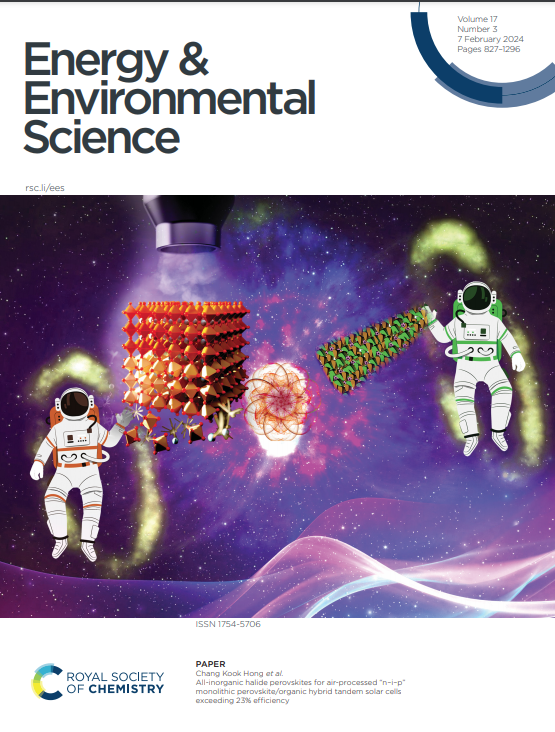Transition pathways to electrified chemical production within sector-coupled national energy systems
IF 30.8
1区 材料科学
Q1 CHEMISTRY, MULTIDISCIPLINARY
引用次数: 0
Abstract
The chemical industry's transition to net-zero greenhouse gas (GHG) emissions is particularly challenging due to the carbon inherently contained in chemical products, eventually released to the environment. Fossil feedstock-based production can be replaced by electrified chemical production, combining carbon capture and utilization (CCU) with electrolysis-based hydrogen. However, electrified chemical production requires vast amounts of clean electricity, leading to competition in our sector-coupled energy systems. In this work, we investigate the pathway of the chemical industry towards electrified production within the context of a sector-coupled national energy system's transition to net-zero emissions. Our results show that the sectors for electricity, low-temperature heat, and mobility transition before the chemical industry due to the required build-up of renewables, and to the higher emissions abatement of heat pumps and battery electric vehicles. The chemical industry transitions last together with high-temperature heat, beginning with methanol, then ammonia, the olefins, and finally the aromatics. To achieve the net-zero target, the energy system relies on clean energy imports to cover 41% of its electricity needs, largely driven by the high energy requirements of a fully electrified chemical industry. Nonetheless, a partially electrified industry combined with dispatchable production alternatives provides flexibility to the energy system by enabling electrified production when renewable electricity is available. Hence, a partially electrified, diversified chemical industry can support the integration of intermittent renewables, serving as a valuable component in net-zero energy systems.在部门耦合的国家能源系统内向电气化化工生产过渡的途径
化学工业向净零温室气体(GHG)排放的过渡尤其具有挑战性,因为化学产品中固有的碳含量最终会释放到环境中。基于化石原料的生产可以被电气化的化学生产所取代,将碳捕获和利用(CCU)与基于电解的氢气相结合。然而,电气化化工生产需要大量的清洁电力,导致我们的部门耦合能源系统的竞争。在这项工作中,我们研究了在一个部门耦合的国家能源系统向净零排放过渡的背景下,化学工业向电气化生产的途径。我们的研究结果表明,由于需要建立可再生能源,以及热泵和电池电动汽车的更高减排,电力、低温供热和交通运输部门的转型先于化学工业。化学工业的转变伴随着高温,首先是甲醇,然后是氨,烯烃,最后是芳烃。为了实现净零目标,能源系统依赖进口清洁能源来满足41%的电力需求,这在很大程度上是由完全电气化的化学工业对能源的高需求驱动的。尽管如此,部分电气化工业与可调度的生产替代方案相结合,在可再生电力可用时实现电气化生产,为能源系统提供了灵活性。因此,部分电气化、多样化的化工行业可以支持间歇性可再生能源的整合,成为净零能源系统的重要组成部分。
本文章由计算机程序翻译,如有差异,请以英文原文为准。
求助全文
约1分钟内获得全文
求助全文
来源期刊

Energy & Environmental Science
化学-工程:化工
CiteScore
50.50
自引率
2.20%
发文量
349
审稿时长
2.2 months
期刊介绍:
Energy & Environmental Science, a peer-reviewed scientific journal, publishes original research and review articles covering interdisciplinary topics in the (bio)chemical and (bio)physical sciences, as well as chemical engineering disciplines. Published monthly by the Royal Society of Chemistry (RSC), a not-for-profit publisher, Energy & Environmental Science is recognized as a leading journal. It boasts an impressive impact factor of 8.500 as of 2009, ranking 8th among 140 journals in the category "Chemistry, Multidisciplinary," second among 71 journals in "Energy & Fuels," second among 128 journals in "Engineering, Chemical," and first among 181 scientific journals in "Environmental Sciences."
Energy & Environmental Science publishes various types of articles, including Research Papers (original scientific work), Review Articles, Perspectives, and Minireviews (feature review-type articles of broad interest), Communications (original scientific work of an urgent nature), Opinions (personal, often speculative viewpoints or hypotheses on current topics), and Analysis Articles (in-depth examination of energy-related issues).
 求助内容:
求助内容: 应助结果提醒方式:
应助结果提醒方式:


